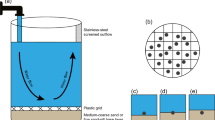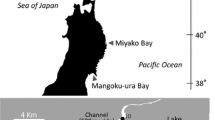Synopsis
Analysis of frozen cores of gravel surrounding the egg pockets of chum salmon, Oncorhynchus keta, collected in the fall revealed that spawning activity by females purged about 75 % of the fine sediments from the stream bed. The egg pocket was one of four distinct vertical strata detected in the cores. There was an undisturbed layer below the egg pocket, and separate bridge and cover strata above the egg pocket, all defined by different particle size distributions. However, by spring most of the egg pockets had been infiltrated with fine sediment and the particle size distribution approached background levels. The most likely physical factors responsible for these results were: (1) intrusion of fine sediments through the cleaned surface gravel, (2) lateral subsurface migration of fine sediment into interstitial voids, (3) scour of the surface gravel and subsequent deposition of a sand rich bedload, and (4) superimposed spawning activity of other fish, causing disturbance of the cleaned surface gravel and exposing the egg pocket to intrusion of fine particles. We conclude that, while female salmon substantially affect the physical environment of their embryos, subsequent sediment transport processes and fine bedload flux tend to return this environment to pre-spawning conditions.
Similar content being viewed by others
References cited
Adams, J.M. & R.L. Beschta. 1980. Gravel bed composition in Oregon coastal streams. Can. J. Fish. Aquat. Sci. 37: 1514–1521.
Beschta, R.L. & W.L. Jackson. 1979. The intrusion of fine sediments into a stable gravel bed. J. Fish. Res. Board Can. 36: 204–210.
Blumer, L.S. 1982. A bibliography and categorization of bony fishes exhibiting parental care. Zool. J. Linnean Soc. 76: 1–22.
Burner, C.J. 1951. Characteristics of spawning nests of Columbia River salmon. U.S. Fish. Bull. 52: 97–110.
Carling, P.A. & N.A. Reader. 1982. Structure, composition and bulk properties of upland stream gravels. Earth Surf. Proc. Landforms 7: 349–365.
Cederholm, C.J. & L.M. Reid. 1987. Impacts of forest management on coho salmon (Oncorhynchus kisutch) populations of the Clearwater River, Washington: a project summary. pp. 373–398. In: E.O. Salo & T.W. Cundy(ed.) Streamside Management: Forestry and Fishery Interactions, College of Forest Resources, University of Washington, Seattle.
Chapman, D.W. 1988. Critical review of variables used to define effects of fines in redds of large salmonids. Trans. Amer. Fish. Soc. 117: 1–21.
Coble, D.W. 1961. Influence of water exchange and dissolved oxygen in redds on survival of steelhead trout embryos. Trans. Amer. Fish. Soc. 90: 469–474.
Conover, W.J. 1980. Practical non-parametric statistics. John Wiley & Sons, New York. 494 pp.
Crisp, D.T. 1994. Reproductive investment of female brown trout, Salmo trutta L., in a stream and reservoir system in northern England. J. Fish Biol. 44: 343–349.
Crisp, D.T. 1993. The ability of U.K. salmonid alevins to emerge through a sand layer. J. Fish Biol. 43: 656–658.
Crisp, D.T. & P.A. Carling. 1989. Observations on siting, dimensions and structure of salmonid redds. J. Fish Biol. 34: 119–134.
Duncan, S.H. & J.W. Ward. 1985. The influence of watershed geology and forest roads on the composition of salmon spawning gravel. Northwest Sci 3: 204–212.
Edington, J.R. 1984. Some observations of fine sediment and gravels of five undisturbed watersheds. pp. 109–114. In: W.R. Meehan, T.R. Merrell, Jr. & T.A. Hanley (ed.) Fish and Wildlife Relationships in Old-growth Forests, Proceedings of a Symposium Held in Juneau, Alaska, 12–15 April 1982, American Institute of Fishery Research Biologists.
Einstein, H.A. 1968. Deposition of suspended particles in a gravel bed. Amer. Soc. Civil Engin., J. Hydrol. Div. 94(HY5): 1197–1205.
Everest, F.H., R.L. Beschta, J.C. Scrivener, K.V. Koski, J.R. Sedell & C.J. Cederholm, 1987. Fine sediment and salmonid production: a paradox. pp. 98–142. In: E.O. Salo & T.W. Cundy(ed.) Streamside Management: Forestry and Fishery Interactions, College of Forest Resources, University of Washington, Seattle.
Foerster, R.E. 1968. The sockeye salmon, Oncorhynchus nerka. Bull. Fish. Res. Board Can. 162: 422 p.
Gomez, B. 1983. Representative sampling of sandy fluvial gravels. Sed. Geol. 34: 301–306.
Gross, M.R. & R.C. Sargent. 1985. The evolution of male and female parental care in fishes. Amer. Zool. 25: 807–822.
Grost, T.G., W.A. Hubert & T.A. Wesche. 1991a. Field comparison of three devices used to sample substrate in small streams. N. Amer. J. Fish. Manag. 11: 347–351.
Grost, R.T., W.A. Hubert & T.A. Wesche. 1991b. Description of brown trout redds in a mountain stream. Trans. Amer. Fish. Soc. 120: 582–588.
Healey, M.C. 1991. Life history of chinook salmon. pp. 311–393. In: C. Groot & L. Margolis(ed.) Pacific Salmon Life Histories. University of British Columbia Press, Vancouver.
Heard, W.R. 1991. Life history of chum salmon. pp. 119–230. In: C. Groot & L. Margolis(ed.) Pacific Salmon Life Histories, University of British Columbia Press, Vancover.
Holtby, L.B. & M.C. Healey. 1986. Selection for adult body size in female coho salmon (Oncorhynchus kisutch). Can. J. Fish. Aquat. Sci. 43: 1946–1959.
Kondolf, G.M. & M.G. Wolman. 1993. The sizes of salmonid spawning gravels. Water Resour. Res. 29: 2275–2285.
Kondolf, G.M., M.J. Sale & M.G. Wolman. 1993. Modification of fluvial gravel size by spawning salmonids. Water Resour. Res. 29: 2265–2274.
Leman, V.N. 1993. Spawning sites of chum salmon, Oncorhynchus keta: microhydrological regime and viability of progeny in redds (Kamchatka River basin). J. Ichthyol. 33: 104–117.
Lisle, T.E. 1989. Sediment transport and resulting deposition in spawning gravels, north coastal California. Water Resour. Res. 25: 1303–1319.
Lisle, T.E. & J. Lewis. 1992. Effects of sediment transport on survival of salmonid embryos in a natural stream: a simulation approach. Can. J. Fish. Aquat. Sci. 49: 2337–2344.
McNeil, W.J. 1964. Redd superimposition and egg capacity of pink salmon spawning beds. J. Fish. Res. Board Can. 21: 1385–1396.
McNeil, W.J. 1966. Effect of the spawning bed environment on reproduction of pink and chum salmon. U.S. Fish. Bull. 65: 495–523.
Montgomery, D.R., J.M. Buffington, N.P. Peterson, D. Schuett-Hames & T.P Quinn. 1996. Salmonid modifications of gravel streambeds: implications for bed surface mobility and embryo survival. Can. J. Fish. Aquat. Sci. (in press).
Mosley, M.P. & D.S. Tindale. 1985. Sediment variability and bed material sampling gravel-bed rivers. Earth Surf. Proc. Landforms 10: 465–482.
Phillips, R.W., R.L. Lantz, E.W. Claire & J.R. Moring. 1975. Some effects of gravel mixtures on emergence of coho salmon and steelhead trout fry. Trans. Amer. Fish. Soc. 104: 461–466.
Reid, L.M. & T. Dunne. 1984. Sediment production from forest road surfaces. Water Resour. Res. 20: 1753–1761.
Reid, I., L.E. Frostick & J.T. Layman. 1985. The incidence and nature of bedload transport during flood flows in coarse-grained alluvial channel. Earth Surf. Proc. Landforms 10: 33–44.
Salo, E.O. 1991. Life history of chum salmon. pp. 231–309. In: C. Groot & L. Margolis(ed.) Pacific Salmon Life Histories, University of British Columbia Press, Vancouver.
Scrivener, J.C. & M.J. Brownlee. 1989. Effects of forest harvesting on spawning gravel and incubation survival of chum (Oncorhynchus keta) and coho salmon (O. kisutch) in Carnation Creek, British Columbia. Can. J. Fish. Aquat. Sci. 46: 681–696.
Sear, D.A. 1993. Fine sediment infiltration into gravel spawning beds within a regulated river experiencing floods: ecological implications for salmonids. Reg. Rivers: Res. Manag. 8: 373–390.
Sheridan, W.L., M.P. Perensovich, T. Faris & K.V. Koski. 1984. Sediment content of streambed gravels in some pink salmon spawning streams in Alaska. pp. 153–165. In: W.R. Meehan, T.R. Merrell, Jr. & T.A. Hanley (ed.) Fish and Wildlife Relationships in Old-growth Forests, Proceedings of a Symposium Held in Juneau, Alaska, 12–15 April 1982, American Institute of Fishery Research Biologists.
Shumway, D.L., C.E. Warren & P. Doudoroff. 1964. Influence of oxygen concentration and water movement on the growth of steelhead trout and coho salmon embryos. Trans. Amer. Fish. Soc. 93: 342–356.
Tagart, J.V. 1984. Coho salmon survival from egg deposition to fry emergence. pp. 173–182. In: J.M. Walton & D.B. Houston(ed.) Proceedings of the Olympic Wild Fish Conference, Peninsula College and Olympic National Park, Port Angeles.
Thorne, R.E. & J.J. Ames. 1987. A note on the variability of marine survival of sockeye salmon (Oncorhynchus nerka) and effects of flooding on spawning success. Can. J. Fish. Aquat. Sci. 44: 1791–1795.
van den Berghe, E.P. & M.R. Gross. 1984. Female size and nest depth in coho salmon (Oncorhynchus kisutch). Can. J. Fish. Aquat. Sci. 41: 204–206.
van den Berghe, E.P. & M.R. Gross. 1989. Natural selection resulting from female breeding competition in a Pacific salmon (coho: Oncorhynchus kisutch). Evolution 43: 125–140.
Wentworth, C.K. 1922. A scale of grade and class terms for clastic sediments. J. Geol. 30: 377–392.
Winemiller, K.O. & K.A. Rose. 1992. Patterns of life-history diversification in North American fishes: implications for population regulation. Can. J. Fish. Aquat. Sci. 49: 2196–2218.
Wootton, R.J. 1984. Introduction: strategies and tactics in fish reproduction. pp. 1–12. In: G.W. Potts & R.J. Wootton(ed.) Fish Reproduction — Strategies and Tactics, Academic Press, London.
Young, M.K., W.A. Hubert & T.A. Wesche. 1989. Substrate alteration by spawning brook trout in a southeastern Wyoming stream. Trans. Amer. Fish. Soc. 118: 379–385.
Young, M.K., W.A. Hubert & T.A. Wesche. 1990. Fines in redds of large salmonids. Trans. Amer. Fish. Soc. 119: 156–162.
Young, M.K., W.A. Hubert & T.A. Wesche. 1991. Biases associated with four stream substrate samplers. Can. J. Fish. Aquat. Sci. 48: 1882–1886.
Zar, J.H. 1984. Biostatistical analysis. Prentice-Hall, Englewood Cliffs. 718 pp.
Author information
Authors and Affiliations
Rights and permissions
About this article
Cite this article
Peterson, N.P., Quinn, T.P. Persistence of egg pocket architecture in redds of chum salmon, Oncorhynchus keta . Environ Biol Fish 46, 243–253 (1996). https://doi.org/10.1007/BF00004999
Received:
Accepted:
Issue Date:
DOI: https://doi.org/10.1007/BF00004999




